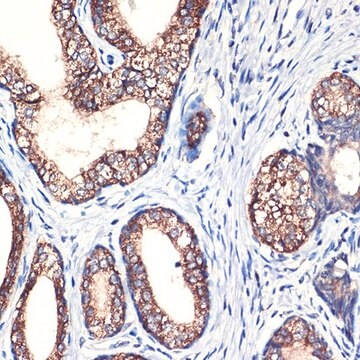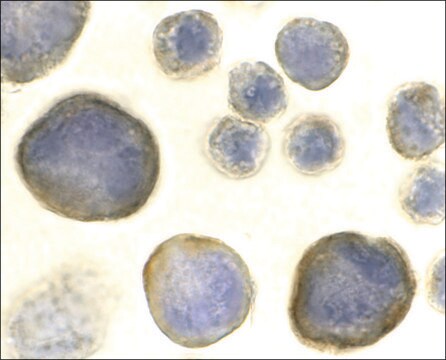SML2306
CTEP
≥98% (HPLC)
동의어(들):
2-Chloro-4-((2,5-dimethyl-1-(4-(trifluoromethoxy)phenyl)-1H-imidazol-4-yl)ethynyl)pyridine, 2-Chloro-4-[2-[2,5-dimethyl-1-[4-(trifluoromethoxy)phenyl]-1H-imidazol-4-yl]ethynyl]pyridine, RO4956371
로그인조직 및 계약 가격 보기
모든 사진(1)
About This Item
실험식(Hill 표기법):
C19H13ClF3N3O
CAS Number:
Molecular Weight:
391.77
MDL number:
UNSPSC 코드:
12352200
NACRES:
NA.77
추천 제품
분석
≥98% (HPLC)
양식
powder
색상
white to beige
solubility
DMSO: 2 mg/mL, clear
저장 온도
2-8°C
SMILES string
CC1=C(C#CC2=CC(Cl)=NC=C2)N=C(C)N1C3=CC=C(OC(F)(F)F)C=C3
InChI
1S/C19H13ClF3N3O/c1-12-17(8-3-14-9-10-24-18(20)11-14)25-13(2)26(12)15-4-6-16(7-5-15)27-19(21,22)23/h4-7,9-11H,1-2H3
InChI key
GOHCTCOGYKAJLZ-UHFFFAOYSA-N
관련 카테고리
생화학적/생리학적 작용
Brain-penetrant, orally active, potent and selective mGluR5 (mGlu5) negative allosteric modulator & inverse agonist.
CTEP (RO4956371) may be used as a therapeutic to reduce hippocampal long-term depression, protein synthesis, and audiogenic seizures in the fragile X mental retardation 1 (Fmr1) knockout mouse.
CTEP is a high-affinity, orally active, potent and selective metabotropic glutamate receptor 5 (mGlu5 or mGluR5) negative allosteric modulator (NAM) and inverse agonist (human/mouse/rat mGlu5 Kd = 1.7/1.8/1.5 nM; IC50 against quisqualate stimulation = 6.4/16.8/8/8 by IP accumulation or 11.4/42/4/6.9 by Ca2+ mobilization using human/mouse/rat mGlu5 HEK293 transfectants; IC50 = 40.1 nM against constitutive IP level in human mGlu5 HEK293) with >1000-fold selectivity over 103 molecular targets, including all known mGluRs. CTEP is an excellent tool compound for long-term in vivo studies (in mice and rats) with good pharmacokinetic properties (B/P ratio = 2.6, oral bioavailability ~100%, T1/2 ~18 hrs post 4.5 mg/kg p.o. in mice) and reported to display 30- to 100-fold higher in vivo potency than MPEP and fenobam in two rodent behavioral models sensitive to antianxiety drugs.
Storage Class Code
11 - Combustible Solids
WGK
WGK 3
Flash Point (°F)
Not applicable
Flash Point (°C)
Not applicable
가장 최신 버전 중 하나를 선택하세요:
Di Tian et al.
Nature neuroscience, 18(2), 182-184 (2015-01-13)
Human chromosome 16p11.2 microdeletion is the most common gene copy number variation in autism, but the synaptic pathophysiology caused by this mutation is largely unknown. Using a mouse with the same genetic deficiency, we found that metabotropic glutamate receptor 5
Aubin Michalon et al.
Neuron, 74(1), 49-56 (2012-04-17)
Fragile X syndrome (FXS) is the most common form of inherited intellectual disability. Previous studies have implicated mGlu5 in the pathogenesis of the disease, but a crucial unanswered question is whether pharmacological mGlu5 inhibition is able to reverse an already
Alison Hamilton et al.
Cell reports, 15(9), 1859-1865 (2016-05-24)
Beta-amyloid (Aβ) oligomers contribute to the pathophysiology of Alzheimer disease (AD), and metabotropic glutamate receptor 5 (mGluR5) has been shown to act as a receptor for both Aβ oligomers and cellular prion proteins. Furthermore, the genetic deletion of mGluR5 in
Stephanie A Barnes et al.
The Journal of neuroscience : the official journal of the Society for Neuroscience, 35(45), 15073-15081 (2015-11-13)
Previous studies have hypothesized that diverse genetic causes of intellectual disability (ID) and autism spectrum disorders (ASDs) converge on common cellular pathways. Testing this hypothesis requires detailed phenotypic analyses of animal models with genetic mutations that accurately reflect those seen
Aubin Michalon et al.
Biological psychiatry, 75(3), 189-197 (2013-08-06)
Fragile X syndrome (FXS) is the most common genetic cause for intellectual disability. Fmr1 knockout (KO) mice are an established model of FXS. Chronic pharmacological inhibition of metabotropic glutamate receptor 5 (mGlu5) in these mice corrects multiple molecular, physiological, and
자사의 과학자팀은 생명 과학, 재료 과학, 화학 합성, 크로마토그래피, 분석 및 기타 많은 영역을 포함한 모든 과학 분야에 경험이 있습니다..
고객지원팀으로 연락바랍니다.
![1-FLUORO-4-({4-[(4-FLUOROPHENYL)ETHYNYL]PHENYL}ETHYNYL)BENZENE AldrichCPR](/deepweb/assets/sigmaaldrich/product/structures/112/518/ab57450e-29f4-405f-92c7-12e12f020121/640/ab57450e-29f4-405f-92c7-12e12f020121.png)


![METHYL 4-[(4-PENTYLPHENYL)ETHYNYL]PHENYL ETHER AldrichCPR](/deepweb/assets/sigmaaldrich/product/structures/126/521/fc50dedc-a35f-4a9e-978b-0fc34115f916/640/fc50dedc-a35f-4a9e-978b-0fc34115f916.png)




